Search the Special Collections and Archives Portal
Search Results
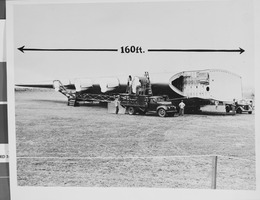
Photograph of the construction of Howard Hughes' Hercules, June 12, 1946
Date
1946-06-12
Archival Collection
Description
Description given with photo: "Prepare to Move "Hercules" Wing, Culver City, Calif. -- One of the two 34-ton wing sections of Howard Hughes' eight-engined Hercules, world's largest flying boat, is put on house-moving dollies in Culver City, Calif., before beginning the 28-mile journey to Los Angeles Harbor, where the mammoth airplane will be assembled for its first test flight, supposedly around the first of the year. A two-day trip will see the wing- 19 feet high, 49 feet wide, 160 feet long - at the $200,000 graving dock at Terminal Island, Calif., which was built specifically for the assembly of the craft. Note comparative size of men working on the wind. Credit (ACME). 6-12-46."
Image
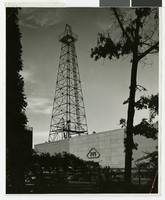
Photograph of the exterior of Hughes Research Laboratories, Culver City, California, circa 1940s
Date
1940 to 1949
Archival Collection
Description
The exterior of Hughes Research Laboratories where rock bits were test-drilled in Culver City, California in the 1940s. Transcribed from note taped to back of photo: "Rock bits are test-drilled in the laboratory under conditions that duplicate, as far as is possible in the laboratory, those encountered in actual drilling. As a result, rotational speeds, loads, and fluid volume are closely controlled. The rig operator occupies a splash-proof booth above the 'cellar floor.' The instruments on his control panel provide for application and measurement of variable axial loading on the drilling bit up to 100,000 lbs., variable rotational speeds up to 400 rpm, measurement of bit penetration over a total vertical travel of 5 feet at rates up to 180 ft. per hour, and torque. On the panel, also, are several controls for the operation of mud pump and other accessory equipment."
Image
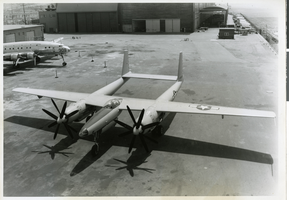
Photograph of the XF-11 prior to its first test flight in Culver City, California July 7, 1947
Date
1947
Archival Collection
Description
Transcribed from press release attached to back of photo: "NEW-DESIGN PHOTO PLANE COMPLETED CULVER CITY, Calif., July 7 -- test-flown today for the first time, the new XF-11 was revealed as one of the world's fastest long-range photographic planes. It was designed and built by Howard Hughes in conjunction with the Air Materiel command engineers. Army officials said that it can attain a speed of more than 400 miles per hour and a ceiling of more than 40,000 feet. The plane has a pressurized cabin making it unnecessary for the crew to use oxygen masks. Outstanding features include a full-span flap, unique eight-camera layout and exceptionally fast take-off." Transcribed from photo sleeve: "Howard Hughes sits in the cockpit of the XF-11, a reconnaissance plane that Hughes built and designed in conjunction with Air Materiel Command engineers. Hughes is preparing for his first test flight in Culver City, California July 7, 1947."
Image
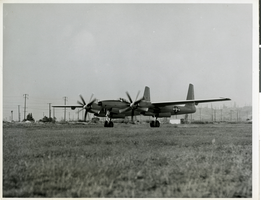
Photograph of the XF-11 as it is about to take off for its first test flight in Culver City, California July 7, 1947
Date
1947
Archival Collection
Description
Transcribed from attachment to photo: "NEW LONG-RANGE PLANE ANNOUNCED CULVER CITY, CALIF., The FX-11 took off today on its first test flight. One of the world's fastest long-range photographic planes, it was designed and built by Howard Hughes in conjunction with Air Materiel Command engineers. It has a wing spread of 101 feet, 4 inches, and is powered by two 3000-horsepower radial engines with eight-bladed contra-rotating propellers. Army officials said it can attain a speed of more than 400 miles per hour and has a ceiling of more than 40,000 feet." Transcribed from photo sleeve: "Howard Hughes sits in the cockpit of the XF-11, a reconnaissance plane that Hughes built and designed in conjunction with Air Materiel Command engineers. Hughes is preparing for his first test flight in Culver City, California July 7, 1947."
Image
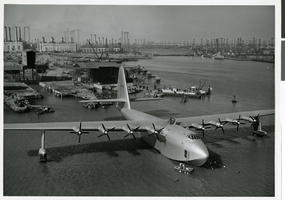
Aerial view of Hughes Flying boat launched, November 1, 1947, in preparation for the historic test flight, November 2 , 1947
Date
1947-11-01
Archival Collection
Description
Aerial view of Hughes Flying boat. Press release attached to back of photo: "LAUNCHING WORLD'S LARGEST PLANE The Hughes Flying boat was launched for the first time November 1, 1947. After the three concrete docks, one containing the hull and two the wing pontoons, were pumped with sea water to the outside level, gates were lowered and the Flying Boat was carefully towed forward by tractors, and by boats as the tail cleared the dock. During taxi tests the following day Howard Hughes made a surprise flight of a mile." Stamped on back of photo: "Hughes Aircraft Photo" and the date "Nov 1 1947." Los Angeles Harbor, Terminal Island are now known as Long Beach.
Image
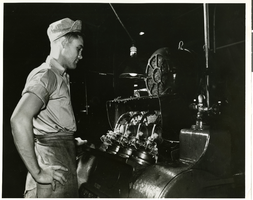
Photograph of a man working on rock bit drilling pieces at the Hughes Tool Co., Houston, Texas, circa 1950s
Date
1950 to 1959
Archival Collection
Description
Transcribed from attached press release: "HUGHES ROCK BIT PRODUCTION more than 500,000 rock bits produced last year by the Hughes Tool Company, Houston, Texas, for drilling the kind of deep wells which now produce 90 per cent of the world's petroleum. The rock bit was invented by Howard Hughes' father and the resulting business became the cornerstone on which Howard Hughes built his industrial empire. The machinist above is performing an operation on the cones which make up the rotating end of the Hughes rock bit." Transcribed from photo sleeve: "The Kearney and Trecker 4 spindle machine at the Hughes Tool Company in Houston, Texas. Ca. 1950s."
Image
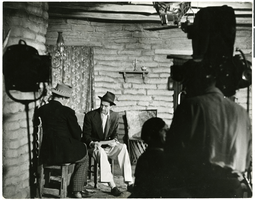
Photograph of Howard Hughes with Walter Huston on the set of The Outlaw, Hollywood, circa 1941
Date
1941
Archival Collection
Description
Howard Hughes on a motion picture set supervising the 'dressing' of a set for use in his production of "The Outlaw." Transcribed from attached press release: "From Russell Birdwell and Associates After an absence of ten years from motion picture production, Howard Hughes resumes film making with the producing and directing of "The Outlaw," the story of Billy the Kid, for Twentieth Century-Fox release. In 1931 he produced and directed "Hell's Angels," from which emerged a glorious new star, Jean Harlow, and in the same year he brought to stardom Paul Muni in "Scarface." And now Hughes, who in 1931 promised two new stars in Harlow and Muni, makes the same promise again with 19-+year old Jane Russell and 21-year old Jack Buetel, playing the top leads in "The Outlaw," the cast of which also includes Thomas Mitchell and Walter Huston. In this picture Hughes is discussing a story point with Jules Furthman, author of the story and screen play on "The Outlaw."
Image
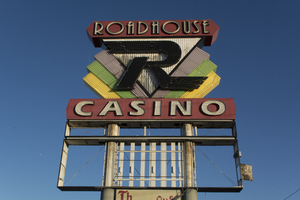
Photographs of Roadhouse Casino sign, Las Vegas (Nev.), March 14, 2017
Date
2017-03-14
2017-09-01
Archival Collection
Description
The Roadhouse Casino sign sits unlit at 2100 North Boulder Highway. Information about the sign is available in the Southern Nevada Neon Survey Data Sheet.
Site address: 2100 N Boulder Hwy
Sign owner: Robert McMackin
Sign details: Roadhouse approved for gaming 1988, Robert McMackin bought the Roadhouse 1992, but it closed 2002. They planned to refurbish and reopen by 2010 but has been in legal trouble and has not reopened.
Sign condition: 2- reader board portion/plastic back lit portion is gone and paint has faded drastically
Sign form: Pylon
Sign-specific description: Big Letters on top "Roadhouse" below Is a Huge Letter "R". Still up but in horrible condition. Reader board is a frame and appears to be scrapped. No upkeep has been made to the sign. There is an array of colors behind the 'R' such as purple, white, yellow and green in a parallel plume shape.
Sign - type of display: Neon
Sign - media: Steel
Sign - non-neon treatments: There must have been plastic on this sign since there is a sign box that would contain it.
Sign environment: This location is on Boulder Hwy. near Sunset Road.
Sign - thematic influences: The letter R in the middle of the sign is remnant of the 1980's car/video game font.
Survey - research locations: Las Vegas Sun Article synopsis https://vegasinc.lasvegassun.com/business/legal/2012/mar/26/city-henderson-reverses-course-roadhouse-casino-li/ Review Journal article https://www.reviewjournal.com/business/casinos-gaming/station-casinos-henderson-settle-roadhouse-dispute/
Survey - research notes: The articles were helpful with finding information on this property since other avenues did not have any information on it.
Surveyor: Wyatt Currie-Diamond
Survey - date completed: 2017-09-01
Sign keywords: Pylon; Neon; Steel; Plastic; Incandescent; Backlit; Back to back
Site address: 2100 N Boulder Hwy
Sign owner: Robert McMackin
Sign details: Roadhouse approved for gaming 1988, Robert McMackin bought the Roadhouse 1992, but it closed 2002. They planned to refurbish and reopen by 2010 but has been in legal trouble and has not reopened.
Sign condition: 2- reader board portion/plastic back lit portion is gone and paint has faded drastically
Sign form: Pylon
Sign-specific description: Big Letters on top "Roadhouse" below Is a Huge Letter "R". Still up but in horrible condition. Reader board is a frame and appears to be scrapped. No upkeep has been made to the sign. There is an array of colors behind the 'R' such as purple, white, yellow and green in a parallel plume shape.
Sign - type of display: Neon
Sign - media: Steel
Sign - non-neon treatments: There must have been plastic on this sign since there is a sign box that would contain it.
Sign environment: This location is on Boulder Hwy. near Sunset Road.
Sign - thematic influences: The letter R in the middle of the sign is remnant of the 1980's car/video game font.
Survey - research locations: Las Vegas Sun Article synopsis https://vegasinc.lasvegassun.com/business/legal/2012/mar/26/city-henderson-reverses-course-roadhouse-casino-li/ Review Journal article https://www.reviewjournal.com/business/casinos-gaming/station-casinos-henderson-settle-roadhouse-dispute/
Survey - research notes: The articles were helpful with finding information on this property since other avenues did not have any information on it.
Surveyor: Wyatt Currie-Diamond
Survey - date completed: 2017-09-01
Sign keywords: Pylon; Neon; Steel; Plastic; Incandescent; Backlit; Back to back
Mixed Content
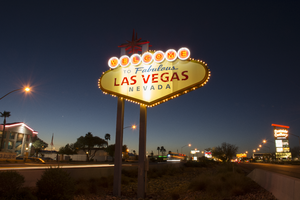
Photographs of "Welcome to Fabulous Las Vegas" sign replica, Las Vegas (Nev.), March 14, 2017
Date
2017-03-14
2017-09-28
Archival Collection
Description
A replica of the "Welcome to Fabulous Las Vegas" sign sits at a median near Boulder Highway at dusk. Information about the sign is available in the Southern Nevada Neon Survey Data Sheet.
Site address: Boulder Hwy
Sign owner: Commissioned by the Boulder Hwy casinos
Sign details: This sign is to pay homage to the original 1959 Welcome to Fabulous Las Vegas sign, but to honor the "Boulder Strip". There are many casinos within this area of Boulder Hwy similar to our famous Las Vegas Blvd. sign.
Sign condition: 5- Very good condition and still works very good
Sign form: Pylon
Sign-specific description: This sign is a replica of the current Welcome to Fabulous Las Vegas sign with identical design and materials used, but is just smaller than the real one
Sign - type of display: Neon, plastic back lit portion and incandescent light bulbs
Sign - media: Steel and plastic
Sign - non-neon treatments: Incandescent light bulbs and plastic back lit portion
Sign animation: Chasing
Notes: incandescent light bulbs on the exterior of the sign.
Sign environment: In the middle of the median on Boulder Hwy. In the middle of the road in front of the East side Cannery and close to the Longhorn casino as well.
Sign designer: Betty Willis
Sign - date of installation: 2007
Sign - thematic influences: Identical in design of the Welcome to Fabulous Las Vegas sign but a bit smaller.
Sign - artistic significance: Googie style is portrayed in the design of this sign.
Survey - research locations: Google maps roadside view, Sign website discussing welc. To fab L.V. sign in general and year of replica installation https://www.signs.com/blog/15-surprising-facts-about-the-las-vegas-sign/ , Las Vegas Sun article https://lasvegassun.com/news/2008/nov/25/ask-mr-sun/
Surveyor: Emily Fellmer
Survey - date completed: 2017-09-28
Sign keywords: Pylon; Neon; Plastic; Backlit; Incandescent; Chasing; Steel
Site address: Boulder Hwy
Sign owner: Commissioned by the Boulder Hwy casinos
Sign details: This sign is to pay homage to the original 1959 Welcome to Fabulous Las Vegas sign, but to honor the "Boulder Strip". There are many casinos within this area of Boulder Hwy similar to our famous Las Vegas Blvd. sign.
Sign condition: 5- Very good condition and still works very good
Sign form: Pylon
Sign-specific description: This sign is a replica of the current Welcome to Fabulous Las Vegas sign with identical design and materials used, but is just smaller than the real one
Sign - type of display: Neon, plastic back lit portion and incandescent light bulbs
Sign - media: Steel and plastic
Sign - non-neon treatments: Incandescent light bulbs and plastic back lit portion
Sign animation: Chasing
Notes: incandescent light bulbs on the exterior of the sign.
Sign environment: In the middle of the median on Boulder Hwy. In the middle of the road in front of the East side Cannery and close to the Longhorn casino as well.
Sign designer: Betty Willis
Sign - date of installation: 2007
Sign - thematic influences: Identical in design of the Welcome to Fabulous Las Vegas sign but a bit smaller.
Sign - artistic significance: Googie style is portrayed in the design of this sign.
Survey - research locations: Google maps roadside view, Sign website discussing welc. To fab L.V. sign in general and year of replica installation https://www.signs.com/blog/15-surprising-facts-about-the-las-vegas-sign/ , Las Vegas Sun article https://lasvegassun.com/news/2008/nov/25/ask-mr-sun/
Surveyor: Emily Fellmer
Survey - date completed: 2017-09-28
Sign keywords: Pylon; Neon; Plastic; Backlit; Incandescent; Chasing; Steel
Mixed Content
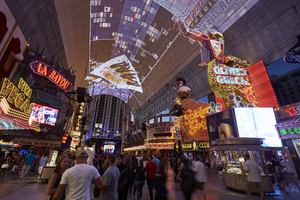
Photographs of La Bayou Casino, Las Vegas (Nev.), June 24, 2016
Date
2016-06-24 to 2017-09-08
Archival Collection
Description
The permanently closed Labayou Casino sits at 15 Fremont Street at the Fremont Street Experience. Information about the sign is available in the Southern Nevada Neon Survery Data Sheet.
Site address: 15 Fremont St
Sign owner: Derek Stevens
Sign details: Opened 1920 as Northern Club By Mayme Stocker. 1943-1960 operated as a few different businesses. 1970 opened as The Coin Castle, 1999 was renovated and opened as La Bayou, 2016 bought by Derek Stevens and torn down.
Sign condition: No longer there
Sign form: Architectural sign
Sign-specific description: Three neon signs site on top of a shack made of wood and sheet metal that is meant to represent something that might be seen in Louisiana. Two windows with green shutters are "open" with T.V. screens inside. Two neon signs sit at the top of the shack that spell out La Bayou in red neon and the cabinet is trimmed with purple neon. At the front of the property, above the entry, is a red neon sign that says "26 New Orleans Daiquiris."
Sign - type of display: Neon and incandescent
Sign - media: Steel, fiberglass
Sign environment: Part of the Fremont Street Experience, next to Golden Gate Casino
Sign - date of installation: c. 1999
Sign - thematic influences: The property has a theme element, which was popular of casinos of Las Vegas in the 1990s.
Sign - artistic significance: Property was decorated with a Louisiana inspired bayou, swamp motif.
Survey - research locations: Newspapers
Survey - research notes: https://www.reviewjournal.com/business/casinos-gaming/mermaids-la-bayou-and-glitter-gulch-come-to-a-close-on-fremont-photos/ https://lasvegassun.com/news/2016/jun/25/patrons-say-farewell-to-mermaids-and-la-bayou-in-d/ http://classiclasvegas.squarespace.com/downtown-history/?currentPage=3
Survey - other remarks: Property was razed 2016
Surveyor: Wyatt Currie-Diamond
Survey - date completed: 2017-09-08
Sign keywords: Architectural; Neon; Incandescent; Steel; Fiberglass
Site address: 15 Fremont St
Sign owner: Derek Stevens
Sign details: Opened 1920 as Northern Club By Mayme Stocker. 1943-1960 operated as a few different businesses. 1970 opened as The Coin Castle, 1999 was renovated and opened as La Bayou, 2016 bought by Derek Stevens and torn down.
Sign condition: No longer there
Sign form: Architectural sign
Sign-specific description: Three neon signs site on top of a shack made of wood and sheet metal that is meant to represent something that might be seen in Louisiana. Two windows with green shutters are "open" with T.V. screens inside. Two neon signs sit at the top of the shack that spell out La Bayou in red neon and the cabinet is trimmed with purple neon. At the front of the property, above the entry, is a red neon sign that says "26 New Orleans Daiquiris."
Sign - type of display: Neon and incandescent
Sign - media: Steel, fiberglass
Sign environment: Part of the Fremont Street Experience, next to Golden Gate Casino
Sign - date of installation: c. 1999
Sign - thematic influences: The property has a theme element, which was popular of casinos of Las Vegas in the 1990s.
Sign - artistic significance: Property was decorated with a Louisiana inspired bayou, swamp motif.
Survey - research locations: Newspapers
Survey - research notes: https://www.reviewjournal.com/business/casinos-gaming/mermaids-la-bayou-and-glitter-gulch-come-to-a-close-on-fremont-photos/ https://lasvegassun.com/news/2016/jun/25/patrons-say-farewell-to-mermaids-and-la-bayou-in-d/ http://classiclasvegas.squarespace.com/downtown-history/?currentPage=3
Survey - other remarks: Property was razed 2016
Surveyor: Wyatt Currie-Diamond
Survey - date completed: 2017-09-08
Sign keywords: Architectural; Neon; Incandescent; Steel; Fiberglass
Mixed Content
Pagination
Refine my results
Content Type
Creator or Contributor
Subject
Archival Collection
Digital Project
Resource Type
Year
Material Type
Place
Language
Records Classification
